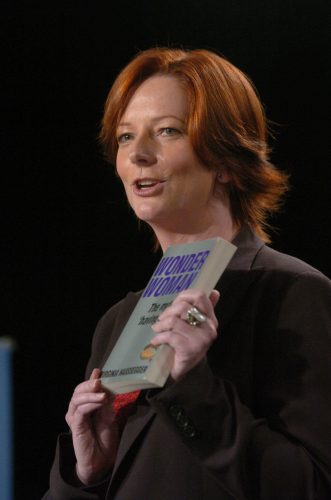Mercifully, it’s over. Those appalling election ads have stopped. That dumb noise, nagging through every television break, has finally been switched off. Now, at last, we can all head out to vote. Pity though that voters’ heads are giddy with idiotic, jingoistic, rhyming ditties.
In an election campaign lacking in inspiration, many candidates have dumped substance for silly slogans and useless information.
For example, I now know that Jacqui has an “i”. Or was it Giulia with a “G”? I know that Doszpot wants the “top spot”; and that Clinton is “from the White House”. Which I assume means he lives in a house painted white, and not in Washington, DC. But I do know that Jac lives here, and that we should put “Bourke to work”.
Overdosed with a bad bout of election-fever advertising, I suspect there are few of us left who can read the word Brindabella, without wondering about that “better fella”. What was his name? And we all know that you’ve got to “go for Coe”.
I wonder if Sir Thomas Hare and Andrew Inglis Clark, who devised the Hare-Clark proportional representation voting system used in the ACT, had any idea what a monster it would be for modern times. While it’s a wonderful instrument of democracy that helps give smaller parties and Independents a presence in the Parliament, Hare-Clark nevertheless rewards profile. Those with face and name recognition are more likely to win a number “1” on the ballot paper of our multi-member electorates.
And in an age of fleeting attention spans and short, sharp sound bites, the hapless political candidate has about 15 seconds to pack a punch, at three words per second. Not much can be conveyed in 45 spoken words. But one wonders, are all these candidates so dreadfully dull and uninspiring that these lame rhymes, and flat puns, are the best their small-town strategists can come up with?
As for the people who wrote and produced the advertising campaigns, they ought to be ashamed. A celebration of rank ordinariness, through daft slogans and unimaginative, outdated production, does all Canberrans a disservice. It highlights our claim to Hicksville. And if calling us “hick” seems a bit harsh, take another look at Val Jeffery’s television ad. It lives in perpetuity, thanks to YouTube. Jeffery makes up in sausage-sizzle sincerity what he lacks in substance and sophistication, with his gripe that others have stuffed it up and that it’s a “flamin’ disgrace”. Perhaps out the back of Bourke, where blokes are used to talkin’ ’bout flamin’ stuff, this kind of political pitch might appeal. But what does it say about the national capital, that ads like this go to air?
Much of the TV advertising in the campaign has been marked by a dearth of creativity and poor production. When candidates aren’t looking awkward and plain silly, sitting in front of waving blue flags, they’re doing robotic movements in some absurdly choreographed version of a Labor Day square dance. What bright spark came up with the idea of marching Labor’s women candidates towards one another, meeting head-on, then turning to the camera like game-show contestants? They would have been better off in cowboy boots doing the Nutbush. At least there would’ve been more moves per beat.
None of this would matter much; except that the calibre of advertising sets the tone of the election. The winners then set the tone of government. And a government – through its style and presentation – then sets the standard for the rest of Canberra. In other words, its image becomes our image. It’s who we are, or at least, who we become.
The trouble with cheap, dull and outdated advertising is invariably it will only engage dull people. While the rest of us sit by and cringe. And disengage.
Running for election, at any level, must be enormously taxing. Promoting oneself doesn’t necessarily come easily to many people. The thankless hours walking the streets, knocking on doors, shaking hands and listening to myriad grievances, strikes me as one of the toughest jobs around. Not to mention the need to grin and bear constant media scrutiny. Yet, despite the sweat and occasional bout of public hostility, some well-meaning souls take the challenge and step up to the plate.
All ACT elections are important, But today’s poll feels more important. Perhaps it’s because Canberra is on the precipice of potentiality. It’s as if right now we are positioned at our favourite roundabout, knowing that the city could head in one of many directions. But, unlike the miserable resident who rings local talkback radio to complain about Canberra’s growing population, and “too many cranes on the skyline”, I think most Canberrans embrace the future, with good grace. Many wish that their city will encourage diversity and celebrate creativity. Which is why we must demand a much better effort from all those involved in the ACT’s political campaigns.
Inane slogans that appeal to childish humour, and snide carping that leaves a nasty stench, do nothing to fire the imagination, or excite our passions.
And just when it seems the bar can’t be set much lower, on Wednesday, Chief Minister Jon Stanhope accused the Opposition Leader Zed Seselja of cancelling the celebration of Christmas.
So, is it true?
There will no longer be a Santa Claus?






